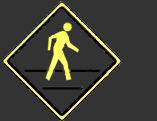
(continued from here)
The lesson learned from this situation is twofold: first of all, the fact that memory can play tricks on you, so what we ‘know’ is sometimes as pliable as a lump of clay. Although Atom tried really hard to make his second map as ‘accurate’ as possible and was therefore quite miffed at the inconsistencies between the two, I would say that the map WAS accurate as an extremely candid portrayal of the impressions that he has committed to his memory of his childhood street, over 20 years after the fact. I do understand his reaction though. To witness physical evidence of one’s own memory in the process of decaying is discomforting to say the least. The last time I happened upon a map of the Paris Metro since the year that I lived there, I at once kicked myself and shivered profusely to see a stop I’d long forgotten about, labeled Denfert-Rochereau. These two hyphenated words, denoting that familiar station with its corridors and unmistakable siren warning that the doors were closing....that station that I passed by a thousand times on the way to my own stop, for an entire year. A sleeping memory was suddenly roused to life. But how on earth could I have forgotten?
Another result of this experiment with Atom supports Saramago’s claim that we all know much more than what we think. There is no one else in the world who knows Linden Hills Blvd., Minneapolis, Minnesota, ca. 1970, in the same way that Atom does, and this idea can be applied to all of us. Even the perception of visual elements like colors are up for interpretation – while many people look at a shadow and see ‘grey --- black mixed with white,’ my painting background would lead me to see blue-toned, reddish, burnt umber, and sepia shadows. Objects, colors, streets, and neighborhoods may have constant, rigid measurements, but the interpretation and organization of it is the result displayed so vividly on the documents we create for ourselves. If we observe not only what we include, but also what we omit, then we will further understand what we actually know. Laurie Hogin, a very talented painter and inspirational professor of mine used to emphatically repeat to our studio class, “PAY ATTENTION TO WHAT YOU PAY ATTENTION TO!” Taking a photo of one thing means we didn’t take a photo of something directly next to it. Including certain elements on a map means we left out something else, either due to lack of knowledge or being aware yet deeming it unimportant. When I ask for a map to the nearest exit ramp of the highway, the gas station attendant will probably leave out the location of the opera house on the other side of town. If I asked an architect to draw me a map of Chicago, it would appear quite different to that of a postal worker, which in turn would contrast the map of a graffiti writer. If I searched for everyone else who grew up on Linden Hills Bld., Minneapolis ca. 1970 and had each of them do the same exercise as Atom, I’m certain that the Jones’ map would differ from the Andersons; which would contrast “Z-Lips’” version, and....who exactly is this Grimes character...?
Module V. The Paperless Map and Related Stories
The combination of unique knowledge that each of us gleans from the vantage point of our personal space ships is the machine that creates multiple, parallel worlds all existing in unison. The physical and emotional puzzles suspended in space form tight webs for us to decode, and a map is one of the tools we use. Its the multi-colored topographical depiction of a tropical rainforest, and the featherlight napkin covered with squiggly lines indicating where Rock River passes through Sterling, Illinois.
Its the conversation I recently had at a bar where my rounded fingers formed a circle in midair, and my other hand’s index finger pointed to the bottom-right of this circle: a paperless map created in order to explain to my amicable company where Cleveland, Ohio was in proximity to Lake Erie. Or its the deja-vu experience when I wondered to myself why that Polish gas station I randomly stopped at seemed so familiar until, about 10 minutes in, I realized that I’d been there just one day previous, but had approached it from the opposite direction. Instantly my perception of all space and dimension shifted, as if two mechanical gears had just locked into place. And if ever the daily demands that life dishes out causes me to temporarily forget where I’ve been, who I’ve met and what has moved me, I simply need to revisit my Mapsproject to decode the connections between one place and another, and my memory, like the mechanical gears, just locks into place.
Lori Napoleon lives in Chicago, IL. You can see more of her mapsproject collection at www.subk.net.
